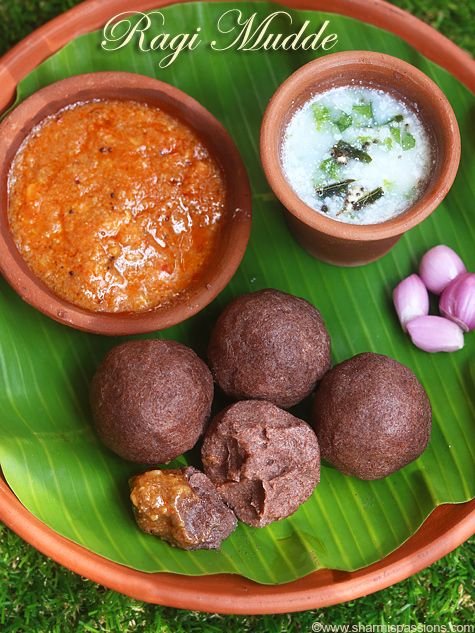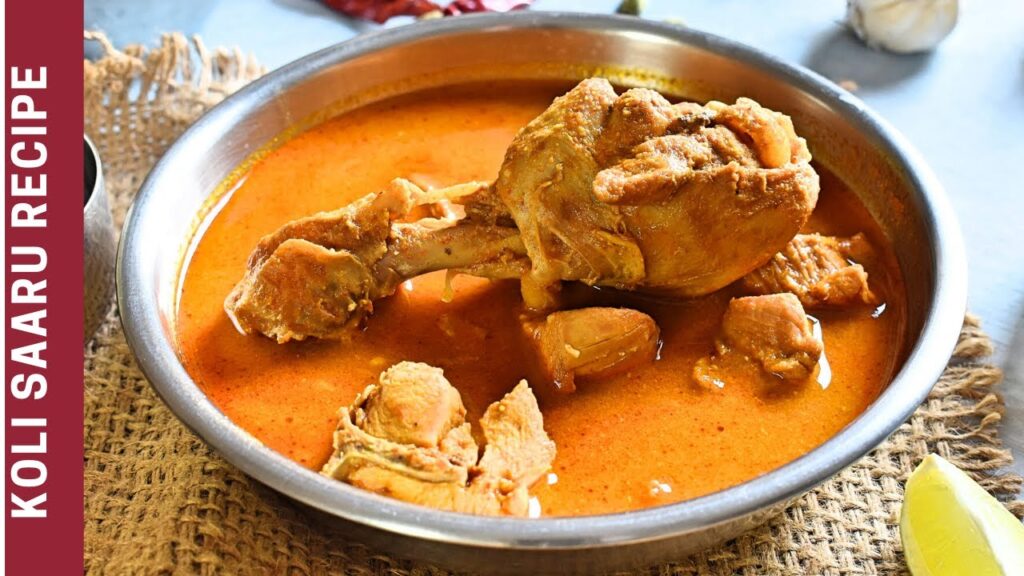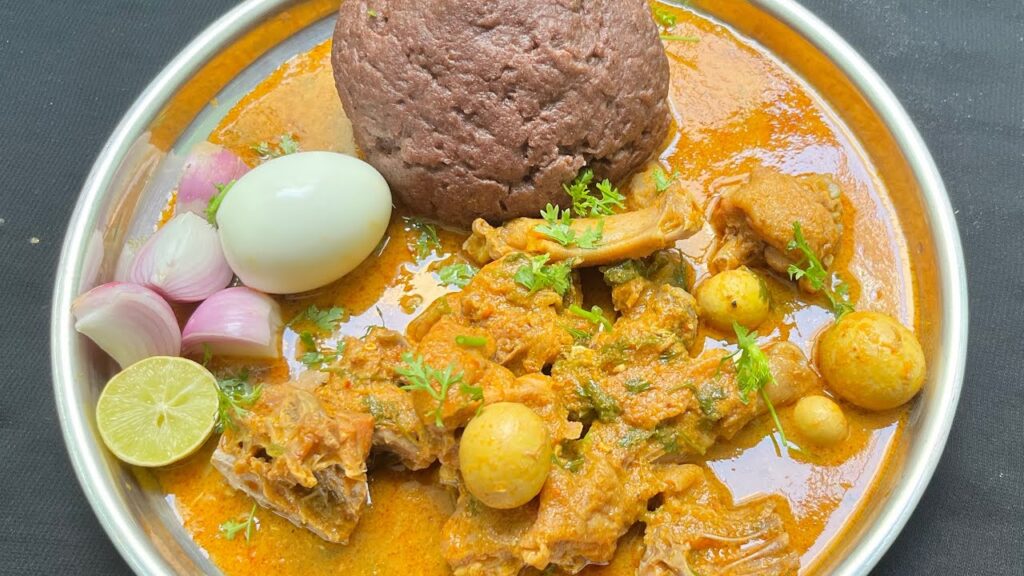When we talk about Karnataka’s culinary identity, one duo stands out as an undisputed king and queen of the kitchen — Ragi Mudde and Naati Koli Saaru. Together, they don’t just make a meal; they serve a tradition, a memory, and a lifestyle that has been passed down generations.
Let’s dive into the legacy, nutrition, culture, and deep emotional connection behind this iconic pair — a dish that’s as earthy and powerful as the land it comes from.
🌾 The Humble Hero: Ragi Mudde
What is Ragi Mudde?

Ragi Mudde (pronounced raa-ghee mood-day) is one of Karnataka’s most iconic and nutritious staple foods. Made from finger millet flour (ragi hittu) and water, it’s cooked into a thick, sticky dough and rolled into round balls. It may look simple, but Ragi Mudde is deeply rooted in tradition, health, and rural life, especially in South Karnataka districts like Mandya, Hassan, Mysuru, Ramanagara, and Chamarajanagar.
Let’s break down what makes Ragi Mudde so special:
🌾 The Grain Behind the Dish: Ragi (Finger Millet)
Ragi is an ancient millet that has been cultivated in India for over 2,000 years. It is a drought-resistant crop that grows well in dry regions, making it a lifeline for farmers in Karnataka.
Nutritional profile of ragi (per 100g):
- High in calcium – essential for bone strength
- Rich in iron – helps prevent anemia
- Packed with dietary fiber – aids digestion and weight control
- Contains complex carbs – provides sustained energy
- Low glycemic index – good for diabetics
Because of these benefits, Ragi is often called a “superfood” and is gaining global attention for its nutritional value.
👨🍳 How is Ragi Mudde Made?
The process of making Ragi Mudde is simple but requires technique. Here’s a basic outline:
Ingredients:
- Ragi flour (finger millet flour)
- Water
- A pinch of salt (optional)
- Ghee (optional, for serving)
Method:
- Boil water in a heavy-bottomed pot.
- Add a spoonful of ragi flour to the boiling water to avoid lumps.
- Slowly add the rest of the flour, stirring continuously with a wooden stick or spatula.
- Keep stirring until it becomes a smooth, thick dough.
- Cover and cook it on low flame for a few more minutes.
- Once done, wet your palms and shape the dough into smooth, round balls.
The final product is a soft, warm, dense ball that’s usually the size of a tennis ball or slightly smaller. It is served hot and fresh, often in pairs.
🍛 How is Ragi Mudde Eaten?
Traditionally, Ragi Mudde is not chewed. Yes, that’s right — you swallow it!
Here’s how it’s done:
- Break off a piece with your fingers.
- Dip it in a spicy, flavorful curry like Naati Koli Saaru or Mutton Saaru.
- Swallow it whole, letting the curry flavor the mudde as it goes down.
This unique way of eating helps preserve the soft texture and lets the rich gravies take center stage.
🌱 Why Is It So Popular in Karnataka?
Ragi Mudde is loved not just for its taste and nutrition but for what it represents:
- Farmer’s Fuel: Traditionally eaten by people doing physical labor — farmers, construction workers, and athletes — because it keeps hunger away for long hours.
- Digestive and Cooling: Ragi naturally cools the body and is easy on the stomach, perfect for hot climates.
- Cultural Identity: It’s more than food — it’s an emotion. For many Kannadigas, Mudde represents home, roots, and nostalgia.
In fact, many people from Karnataka, when living in cities or abroad, miss Ragi Mudde more than any other dish. It’s considered soul food by the locals.
💡 Modern Variations & Popularity
While Ragi Mudde is traditionally served with non-veg curries, you’ll also find people pairing it with:
- Bassaru (greens and lentil-based rasam)
- Uppu Saaru (salt-based rasam)
- Soppina Saaru (green leafy vegetable curry)
- Majjige (buttermilk) as a cooling end to the meal
Today, nutritionists recommend Ragi Mudde for:
- Diabetics
- Weight loss diets
- Bone health
- Child nutrition (when softened and mashed)
It has found its way into modern kitchens, diet plans, and health cafes — proving that this age-old dish is still relevant and essential in today’s fast-paced world.
Nutritional Powerhouse
Ragi is a super grain packed with:
- Calcium and Iron – Excellent for bone health and blood circulation.
- Fiber – Keeps you full longer and helps digestion.
- Low Glycemic Index – Perfect for diabetics and those watching their carbs.
No wonder it has sustained farmers, laborers, and athletes for generations.
🍗 The Flavor Bomb: Naati Koli Saaru
What is Naati Koli?

Naati Koli (also spelled Nati Koli) refers to country chicken or desi chicken, a native breed of poultry commonly raised in the rural and semi-urban parts of Karnataka. Unlike commercially raised broiler chickens, Naati Koli is naturally grown, free-range, and far more flavorful. It’s a vital part of Karnataka’s food identity and is the star ingredient in one of the state’s most iconic dishes — Naati Koli Saaru (country chicken curry).
But Naati Koli isn’t just food. It’s tradition. It’s celebration. It’s weekend comfort. Let’s explore why this humble bird is so loved across Karnataka.
🐓 Understanding the Difference: Naati Koli vs Broiler Chicken
| Feature | Naati Koli | Broiler Chicken |
|---|---|---|
| Growth Time | 4–6 months (natural) | 30–45 days (artificial feed) |
| Texture | Firm, chewy, dense | Soft, tender, often bland |
| Flavor | Rich, earthy, gamey | Mild, less pronounced |
| Rearing Method | Free-range, natural diet | Farm-raised, high-protein feed |
| Availability | Limited, local markets | Widely available |
Naati Koli is not just a different meat — it’s a whole different experience. Its tougher texture and deeper flavor require slow cooking and more spice, which is why Naati Koli Saaru is typically made with rich, aromatic masalas and cooked for longer periods.
🌿 How Is Naati Koli Raised?
In rural Karnataka, Naati Koli are often raised in the backyards of homes or small farms, where they roam freely and forage for grains, insects, and greens. They are not injected with hormones or antibiotics, making them healthier and more nutritious.
Their natural lifestyle:
- Strengthens their muscles (hence the chewy meat)
- Builds immunity (leaner fat content)
- Makes them sustainable and organic by default
For generations, these chickens have been an integral part of rural households — both as a source of income and an occasional feast.
🍛 The Culinary Star: Naati Koli Saaru
The most popular way to enjoy Naati Koli is through Naati Koli Saaru, a spicy, rustic curry made with:
- Hand-ground masalas (garam masala, red chilies, pepper, coriander)
- Fresh coconut
- Ginger, garlic, and onions
- Curry leaves and whole spices
- Mustard or groundnut oil for a traditional touch
The chicken is slow-cooked for over an hour, allowing the meat to absorb all the flavor and release its natural juices into the gravy.
This curry is best paired with:
- Ragi Mudde (finger millet balls)
- Rice
- Akki Roti or Jolad Roti (regional flatbreads)
🎉 Naati Koli in Culture and Tradition
In Karnataka, Naati Koli dishes are often reserved for weekends, festivals, or special guests. The entire process — from sourcing the chicken fresh to slow cooking the curry — is seen as a labor of love.
In many villages, Sunday means Naati Koli day, and families gather to share the meal. It’s also part of festive celebrations like:
- Housewarming feasts
- Village fairs and jatres
- Family get-togethers
- Religious offerings in some communities
💪 Health Benefits of Naati Koli
Many people believe that Naati Koli is more medicinal than broiler chicken, especially when cooked with traditional spices. Some health benefits include:
- High in lean protein
- Lower in unhealthy fats compared to processed meat
- Natural source of vitamins like B6, B12
- Improves strength and stamina
- Saaru is often given to people recovering from illness or childbirth
It’s considered a strength-building food in local Ayurveda and folk remedies.
📈 Modern Popularity and Urban Demand
With growing interest in organic, local, and farm-raised food, Naati Koli is making a comeback in urban kitchens, restaurants, and nati-style hotels.
Popular Bangalore restaurants and dhabas like:
- Hotel Shivaji Military Hotel (Jayanagar)
- Nagarjuna Nati Style
- RNR Donne Biryani
- Naati Sogadu
…have Naati Koli dishes as their hero items.
Despite the slightly higher price compared to broiler chicken, food lovers are willing to pay more for the authentic, traditional experience.
🧑🍳 Tips for Cooking Naati Koli at Home
- Marinate well: Use turmeric, curd, salt, and masalas to tenderize the meat.
- Cook low and slow: Rushing the process will result in tough, undercooked meat.
- Use local oils and spices: Groundnut oil, Byadgi chillies, and fresh curry leaves bring out authentic flavor.
- Pair wisely: Serve with ragi mudde, rice, or chapati for a balanced, hearty meal.
A Sunday Ritual
In many Kannada households, especially in the countryside, Sunday is reserved for Naati Koli Saaru. Families buy the chicken fresh in the morning, prepare it patiently, and gather around for a feast of Ragi Mudde and Saaru — often with side dishes like Mutton Fry, chutneys, or kosambari.
💑 Why Are They the Perfect Pair?

In Karnataka’s rich culinary heritage, few combinations are as celebrated and satisfying as Ragi Mudde (finger millet balls) paired with Naati Koli Saaru (country chicken curry). Individually, both are power-packed dishes with deep roots in the region’s rural lifestyle. But when they come together on a plate, something magical happens — a perfect balance of taste, texture, nutrition, and tradition.
So, what makes this humble duo such an iconic power couple in Karnataka cuisine? Let’s explore.
🥣 1. The Ultimate Balance of Flavor & Texture
- Ragi Mudde is earthy, neutral, soft, and slightly bland.
- Naati Koli Saaru is bold, spicy, aromatic, and rich.
Together, they balance each other beautifully. The blandness of the Ragi Mudde allows the complex flavors of the spicy curry to shine without overwhelming your palate. Each bite delivers contrast — soft and chewy mudde coated in hot, peppery gravy, making the experience wholesome and deeply satisfying.
🔥 2. Heat Meets Cool: A Natural Combination
Ragi is a naturally cooling grain, making it perfect for hot climates. It’s gentle on the stomach and helps maintain internal temperature. On the other hand, Naati Koli Saaru is made with warming spices like pepper, ginger, garlic, and red chilies, which can heat up the body.
When eaten together:
- The cooling nature of Ragi balances the heating effect of the curry.
- It creates a harmonious thermal balance — making it ideal even for regular consumption, unlike many spicy dishes.
🍗 3. Nutritionally Complete Meal
This combination isn’t just tasty — it’s incredibly healthy and well-rounded:
| Nutrient | Ragi Mudde | Naati Koli Saaru |
|---|---|---|
| Carbs | Complex carbs, fiber | Minimal |
| Protein | Moderate | High |
| Iron & Calcium | Very High | Moderate |
| Fats | Low | Moderate (good fats from meat & oil) |
The mudde provides sustained energy and fiber, while the chicken curry adds high-quality protein and vital amino acids. Together, they offer a complete meal for strength, stamina, and digestion — especially useful for farmers, laborers, and athletes.
🫱🏽🫲🏽 4. Swallow, Don’t Chew – The Art of Eating
Ragi Mudde is unique because it’s swallowed, not chewed. The smooth, pliable texture of the mudde is meant to soak in the curry and slide down the throat. This makes the curry a critical component — it must be flavorful, hot, and slightly runny to coat the mudde well.
Naati Koli Saaru, with its deep, rich gravy and slow-cooked meat, fits this role perfectly. It’s not too thick, not too watery — just the right consistency to complement mudde.
🏡 5. Rooted in Rural Life and Culture
This combination is more than food — it’s a symbol of Karnataka’s rustic charm. For generations, rural households have relied on this duo for:
- Sustenance during long working days
- Family bonding over weekend meals
- Celebrations and festivals
In villages, this meal is often cooked fresh on Sundays — with chicken bought in the morning and the curry slow-cooked over firewood. The mudde is shaped by hand and served piping hot. It’s a labor of love, enjoyed slowly and with gratitude.
🍴 6. A Meal That Invites Sharing
There’s something incredibly communal about a Ragi Mudde and Naati Koli meal. It’s usually:
- Eaten with hands
- Served in large portions
- Shared with family or guests on special occasions
The nature of the dish encourages togetherness, conversation, and tradition — making it far more than just a plate of food.
📈 7. Modern Recognition of a Timeless Pair
Today, with the rise in awareness about:
- Millet-based diets
- Local, sustainable food
- Organic protein sources
…this age-old combo is now being appreciated by the health-conscious generation, food bloggers, and even chefs in five-star restaurants.
From traditional homes to Nati-style eateries in Bengaluru, Ragi Mudde and Naati Koli are now celebrated both for their taste and legacy.
🌿 The Cultural Legacy

Food is more than sustenance—it’s identity, heritage, and memory. In Karnataka, few dishes embody this idea as deeply as Ragi Mudde (ragi balls) and Naati Koli Saaru (country chicken curry). What appears to be a simple, rustic meal on the plate is, in reality, a reflection of centuries-old agricultural practices, community values, and regional pride.
Let’s explore how this humble pair has woven itself into the cultural fabric of Karnataka.
🏡 A Symbol of Rural Strength and Simplicity
Ragi Mudde and Naati Koli are deeply rooted in village life, particularly in South Karnataka. For generations, this meal has been the backbone of households where farmers, laborers, and herders needed wholesome, high-energy food to sustain their long, physically demanding days.
- Ragi, or finger millet, is a crop that grows easily in dry, tough soil. It doesn’t need much water, making it ideal for regions with low rainfall.
- Naati Koli is reared naturally in backyards and farms, often fed kitchen scraps and allowed to roam freely.
This combination evolved not just out of tradition, but out of necessity, sustainability, and wisdom — making it a powerful example of how food adapts to the land and lifestyle.
🫱🏽🫲🏽 A Weekend Ritual and Family Bonding Tradition
In many Kannada homes, especially in rural districts, Sundays are sacred for Ragi Mudde and Naati Koli Saaru. The day starts with a trip to the local market to buy freshly slaughtered Naati Koli. Then the family comes together in the kitchen—one person making mudde, another preparing the masala, while the curry simmers slowly in the background.
This isn’t fast food — it’s slow, deliberate, and made with love.
For many, this Sunday meal is not just about eating but about slowing down, connecting, and celebrating tradition. Children wait eagerly, elders oversee the spices, and the aroma brings everyone to the table.
🧓🏽 Passed Down Through Generations
Ragi Mudde and Koli Saaru are also dishes of oral tradition. Recipes are not found in cookbooks — they are whispered from grandmothers to daughters, taught by watching, stirring, tasting, and adjusting.
- The perfect consistency of mudde.
- The right time to add coconut to the curry.
- The exact amount of heat from Byadgi chillies.
All of this is learnt through experience, passed down through generations, and remains deeply personal to each household.
🥘 A Dish That Reflects Karnataka’s Diverse Regions
While the core of the dish remains the same, the regional variations in spices, techniques, and accompaniments are striking:
- In Mysuru and Mandya, you may find coconut-heavy masala with coriander and pepper.
- In Chikmagalur and Hassan, the saaru tends to be more rustic, darker, and spicier.
- In some parts of North Karnataka, instead of coconut, they may use dry-roasted masalas with jolad roti on the side.
This diversity shows how the same two elements — Ragi Mudde and Koli Saaru — take on new personalities across regions, reflecting local tastes and climate.
🪔 Tied to Festivals, Rituals, and Celebrations
Though a humble meal, Ragi Mudde and Naati Koli Saaru are also part of:
- Village temple feasts (Jatre or Jatra) where food is prepared in large community kitchens.
- Housewarming functions and family gatherings in rural homes.
- Post-harvest celebrations, where farmers gather for hearty meals to mark the end of the farming season.
- Post-partum care and recovery diets — because it’s considered strengthening for the body.
In many communities, the meal is a celebration of abundance, effort, and reward — cooked when the work is done, and there is time to savor it.
🪵 Cooking in Firewood Kitchens and Mud Pots
In traditional homes, this dish was always cooked using firewood stoves (Hande) and served in mud pots or on banana leaves. The smoky flavor of firewood-cooked Koli Saaru, combined with hand-rolled Mudde, gave the dish a unique authenticity that is hard to recreate on a gas stove.
The act of cooking itself was a community effort, often involving multiple generations of the family.
📈 Cultural Revival in Modern Times
In recent years, as Karnataka’s culinary traditions gain global recognition, Ragi Mudde and Naati Koli have been rediscovered by urban foodies, health enthusiasts, and culinary historians.
- Health-conscious urbanites are embracing ragi as a superfood.
- Restaurants in Bangalore and Mysuru are now offering Nati-style menus, bringing village cuisine to the city.
- Food influencers and chefs are creating Instagram reels and YouTube videos featuring the pair.
What was once seen as “village food” is now becoming a symbol of authentic, rooted eating in a fast-food world.
💬 Voices from Karnataka
“I still remember my ajji (grandmother) calling us for lunch with a huge pot of Ragi Mudde and a spicy pot of Koli Saaru on the side. That smell, that warmth — nothing compares.”
— Raghavendra M., Mysuru
“No gym diet ever came close to the strength I get from Ragi Mudde with Naati Koli. It’s not just food — it’s medicine, it’s home.”
— Shilpa K., Mandya
🍽️ How to Eat It Like a Local
- Tear off a small piece of the Ragi Mudde.
- Dip it into the hot Naati Koli Saaru generously.
- Swallow (don’t chew!) — let the gravy do its job.
- Repeat until your stomach (and soul) is full.
Optional: Pair with a slice of raw onion, lemon, or a buttermilk drink to complete the meal.
✨ Final Thoughts: More Than Just a Meal
In a world that’s moving fast and forgetting its roots, the combination of Ragi Mudde and Naati Koli is a proud reminder of tradition, nutrition, and soulful eating. It’s proof that real food doesn’t need fancy plating or imported ingredients — just love, patience, and authenticity.
If you ever find yourself in Karnataka, skip the pizza. Walk into a nati-style hotel, sit down, and ask for Ragi Mudde with Naati Koli Saaru. You’ll walk out with a full belly and a fuller heart.
